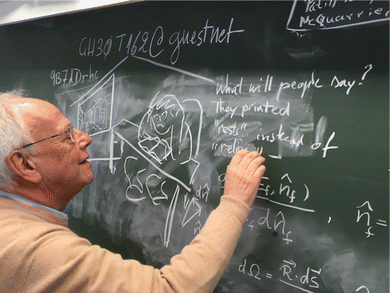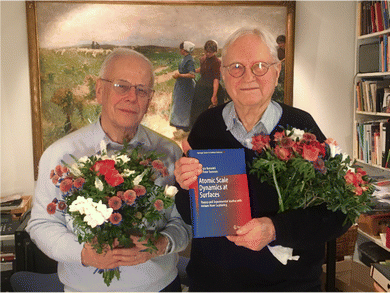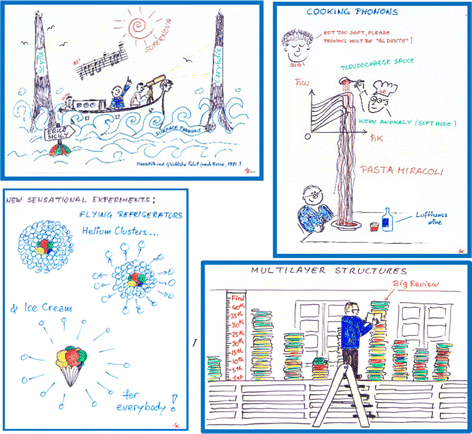Giorgio Benedek: an extraordinary scientist and cultured gentleman
Marco
Bernasconi
 a,
Ricardo
Díez Muiño
a,
Ricardo
Díez Muiño
 bc,
Pedro Miguel
Echenique
bc,
Pedro Miguel
Echenique
 b,
Joseph R.
Manson
b,
Joseph R.
Manson
 bd,
Salvador
Miret-Artés
bd,
Salvador
Miret-Artés
 e and
J. Peter
Toennies
f
e and
J. Peter
Toennies
f
aUniversità di Milano-Bicocca, Italy
bDonostia International Physics Center, Spain
cCentro de Física de Materiales CSIC-UPV/EHU, Donostia, Spain
dClemson University, USA
eInstitute of Fundamental Physics, CSIC, Madrid, Spain
fMax-Planck-Institut für Dynamik und Selbstorganisation, Göttingen, Germany
Giorgio obtained his Doctorate in Physics in 1965 with Gian Franco Nardelli at the University of Milan. The subject of his dissertation, Theory of Infrared Absorption of Substitutional Impurities in Ionic Crystals: Localized Vibrational Modes and Resonances, introduced him to several areas of research such as Raman spectroscopy, bulk lattice dynamics and electron–phonon interactions, which were the subjects of 9 publications with Nardelli including two Physical Review Letters. In 1969, he obtained a junior position at the National Research Council in Milano which eventually developed into a permanent appointment. A milestone of his initial research work was the 1973 publication Surface Lattice Dynamics of Ionic Crystals by the Green Function Method in which he reported the first realistic calculation of the complete dispersion curves of the phonons at crystal surfaces which differ considerably from the dispersion curves in the bulk. This publication marked the beginning of the understanding of the microscopic atomic dynamics at surfaces. These results together with those of the group of F. de Wette in Austin (Texas, USA) had a tremendous impact on the then fledgling field of surface physics.
At least six different experimental groups were inspired and motivated by the new theory and set out to confirm the new understanding. The possibility of measuring surface phonons by using helium atom scattering (HAS) had already been proposed in 1970–71 in two articles by Dick Manson, Vittorio Celli and Nicolas Cabrera. The combination of this theory with the Green's function method for surface dynamics enabled Giorgio to calculate the inelastic helium-atom scattering (HAS) spectra from crystal surfaces, thus demonstrating the feasibility of HAS surface phonon spectroscopy. Much of this work was accomplished in the 70's and early 80's as a visiting professor at the University of Liège (with Roger Evrard and Amand Lucas), the Max-Planck-Institut für Festkörperforschung in Stuttgart (with Heinz Bilz and his group), and the UVA at Charlottesville (with Vittorio Celli). It took until 1980 when the first complete dispersion curves for a crystal surface were measured by Guido Brusdeylins and Bruce Doak in Peter Toennies's group at the Max Planck Institute in Göttingen, Germany. Their experiments fully confirmed the precision of Giorgio's predictions, thus initiating the helium atom scattering (HAS) spectroscopy of surface phonons, much in the same way as inelastic neutron spectroscopy was used for bulk phonons. These achievements led to some prestigious awards from the Alexander-von-Humboldt-Stiftung to support Giorgio's regular visits to Göttingen. They also inspired an important number of Italian and international colleagues which led to major contributions to the theory of surface interaction potentials and scattering theory. Since then, Giorgio enjoyed an extremely fruitful collaboration and a close friendship with Peter Toennies and his group. Giorgio's uncanny attention to experimental data revealed many new, unexpected phenomena often overlooked by the experimentalists.
Giorgio's close cooperation over more than three decades with Peter Toennies and his students and guest researchers, notably Dick Manson and Salvador Miret-Artés, led to a full assessment of HAS as a powerful technique for high-resolution surface phonon spectroscopy. Many important surface phonon effects were discovered such as the anomalous longitudinal resonance in metal surfaces, the influence of surface Lau–Kohn forces, the organ-pipe modes in nanometric films, rotation-flip spectroscopy with o-H2 inelastic scattering. In collaboration with Salvador Miret-Artés the important role of kinematic focusing, bound-state resonances and other novel inelastic focussing resonances mechanisms were also explored and demonstrated to enhance the inelastic signals from surface phonons.
In 1970, after obtaining the university teaching habilitation, Giorgio was appointed lecturer at the University of Milano, until he became first associate, then full professor in 1986. In those years a long list of students and young post-docs joined Giorgio's group, including Gian Paolo Brivio, Leo Miglio, Luciano Colombo, Marco Bernasconi, Carla Molteni, Giovanni Onida, Fiorenza Quasso, Paolo Ruggerone, Stefano Sanguinetti and Paolo Santini. Much theoretical work was carried out at that time on the dynamics of semiconductor surfaces and low-dimensional systems, and, with Heinz Bilz's group at MPI-FKF in Stuttgart, on the theory of ferroelectrics and the multipole-expansion method in surface dynamics. In those years, cluster physics was growing very fast, stimulated by the discovery of fullerenes in 1985. In collaboration with the experimental group of Paolo Milani at the University of Milano, Giorgio studied novel cluster-assembled carbon structures including random carbon schwarzites.
In the late 1990s, Giorgio was among the founders of the Department of Materials Science of the new University of Milano-Bicocca where he moved with his group and where he is now affiliated as Emeritus Professor after his retirement in 2012. At Milano-Bicocca, Giorgio continued his activity on carbon based materials and started addressing surface phonons and low dimensional systems by first principles calculations in collaborations with Marco Bernasconi and new students.
In the late 1990s Giorgio was also introduced by Peter Toennies to the science of quantum liquid droplets and their spectroscopy via doping with a chromophore molecule. Subsequent research in Göttingen and in the USA established He droplets as an ultra-cold non-perturbing universal spectroscopic matrix. The unexpected observation of free molecular rotations suggested that 4He droplets might be superfluid. Giorgio's interpretation of the roton gap in the absorption spectrum sideband of the glyoxal molecule in droplets was crucial for the development of the field since it established for the first time that 4He droplets are superfluid, and more significantly, the first clear evidence for superfluidity in finite-sized systems. A sharp phonon peak was also observed as the first example of localized collective excitation in a fermion droplet. Giorgio in collaboration with Vladimir Hizhnyakov from Tartu University in Estonia developed in 2012 the theory of doped quantum 3He fermionic droplet spectra based on the Lax formalism. In 2020 Giorgio and a former PhD student, Elena Spreafico, were able to explain unexpected magic numbers in 4He droplets by an Auger evaporation mechanism.
In 2003 Robert Grisenti and Peter Toennies discovered periodic oscillations in the vacuum expansion of solid 4He through a micrometric nozzle, called the geyser effect. Previously in 2001 Davide Galli and Luciano Reatto (Milan, Italy) had predicted that solid helium with an enhanced vacancy concentration could exhibit a superfluid behavior at temperatures higher than predicted in 1970 by the Russian theoreticians Andreev and Lifshitz. Giorgio, with Franco Dalfovo (Trento, Italy), attributed the geyser effect to a non-equilibrium concentration of vacancies injected into the solid at the nozzle opening. The bursts occur when the vacancies condense to a superfluid. More recently Giorgio has collaborated to explain the geyser effect in diluted and concentrated isotope He mixtures as well as in the solid flow through a microchannel.
Starting about 2003 Giorgio entered into a collaboration with the theoreticians Pedro Echenique, Evgueni Chulkov and Irina Sklyadneva at the Donostia International Physics Center (DIPC). This research center in San Sebastian (Basque Country) was founded by Pedro Echenique, who presently is its President, and Ricardo Díez Muiño, its director. There, first principles methods were used to fully interpret the HAS phonon data from superconducting ultrathin films collected in Göttingen. The theoretical results confirmed conclusively Giorgio's long-held view that phonons were excited by collisions with the interposed electron cloud via the electron–phonon coupling. Up to that time it had been assumed that surface phonons were excited by the collisions with the surface atoms. Thus they showed that the HAS data provided a direct measure of the so-called mode-selected electron–phonon constants. The theory also explained how it was possible to detect deep sub-surface phonons, a phenomenon which Giorgio called quantum sonar.
In more than 22 publications since 2011, Giorgio has collaborated with the DIPC group in analyzing the experimental data from many surfaces in terms of the new insight gained on electron–phonon coupling. With Dick Manson and Salvador Miret-Artés, he developed a theory of the electron–phonon coupling from the Debye–Waller exponent and applied it to over 50 systems covering several types of conducting surfaces (such as, for example, normal metals, metallic overlayers, chalcogenides and topological surfaces, pnictogen chalcogenides, and graphite and graphene on metal substrates). All the many results and new insight came out of the collaboration with the DIPC. In Giorgio's opinion this was the right place to entirely revise the theory of HAS from metal surfaces and solve old and new puzzles. Presently, after retirement, Giorgio has found a new home at DIPC, where he enjoys the opportunity to interact with many prominent researchers from all over the world. In another entirely new area of research Giorgio, together with Pedro Echenique and the DIPC guests Amand A. Lucas and Marijan Šunjić, developed the theory of coherent plasmon excitations on a fullerene when an electron is stripped away by a highly charged ion flying by. Their theory opened a new perspective in surface plasmon spectroscopy. Giorgio suggested an interesting analogy, the so-called quantum tsunami.
The new understanding on the role of electron–phonon coupling was included in a comprehensive book on the microscopic dynamics at surfaces which had arisen out of the collaboration with Peter Toennies and his group since 1980.3 The book with the title Atomic Scale Dynamics at Surfaces, Theory and Experimental Studies with Helium Atom Scattering appeared in 2018 (Fig. 2). The 14 self-contained chapters describe the development from Lord Rayleigh's mathematical formulation of surface waves to modern ab initio theories. The experiments cover the early results by Otto Stern's group in the 1930s up to the most recent results from today's quantum scattering spectroscopies. All the theoretical and experimental results up to 2018 were analyzed and compiled.
Thanks to the full operation of two 3He-spin echo scattering machines in Cambridge (England) built by Bill Allison, John Ellis and co-workers and HAS laboratories of Wolfgang Ernst in Graz (Austria), Daniel Farías in Madrid (Spain), Bodil Holst in Bergen (Norway), Mario Rocca in Genoa (Italy) and Philippe Roncin in Orsay (France), there is a revival of these types of studies. With the experimental group of Wolfgang Ernst at the University of Graz, Giorgio with former student Davide Campi applied the theory to include semi-metals and semiconductors. Parallel with these investigations Giorgio also entered into a collaboration with the group of Steve Sibener in Chicago related to excitation of the vibrations in organic adlayer films.
Giorgio's outgoing congenial character and his reputation of objective fairness led to his being asked to take part in many university services and scientific committees. Prominent among the latter are his positions as director of the International School of Solid State Physics (1990–present) and as co-director of the International School of Complexity (2004–present) at the Ettore Majorana Foundation and Centre for Scientific Culture. Since 2011 he organized many schools at the center in Erice, Sicily. Giorgio also served on the editorial boards of five international journals and as a board member of the Italian Physical Society. Since 1980 he was involved with the European Physical Society (EPS) as a member of various boards including the Executive Board (1993–1998), and on the editorial boards of Europhysics Letters, European Physical Journal B and Europhysics News. In May 2013 he accepted the job for five years as the Editor in Chief of Europhysics Letters. There he made steps to make sure that China and other developing countries were properly represented among the co-editors and in 2017 established a new series of Focus Issues.
For Giorgio, Science is “the best of all possible works”. In his autobiography2 he wrote “Scientists must be endowed with the same level of creativity as artists, although scientists, unlike artists, only compete with themselves, the attitude towards colleagues preferably being a collaborative one. In most cases scientific knowledge grows through the endeavours of many rather than the solitary efforts of one man, as correctly argued by Marsilius seven centuries ago. Thus we keep referring to the scientific community, we rely on the peer review system, admire those colleagues who have made great achievements, and respect those who had fewer chances. We recognize our (frequent) mistakes, hold scientific integrity to be the highest value, and misconduct to be the worst sin, as it delays scientific progress, besides threatening the confidence in science that we request from nonscientists. Scientists work for the future on two fronts: by producing new knowledge through their papers and by transmitting past and present knowledge to their students. We may well think of our students who have undertaken a successful career in science as our best publications”. In this respect, he also reminded us several times of the title of a book by Rita Levi-Montalcini, “In Praise of Imperfection”. Science is actually considered not just a job, it is more than a profession… it is a “Beruf”, a vocation in the sense of Max Weber.
Giorgio is also a true gentleman as well as a man of deep and broad culture. His father was a much appreciated local physician who grew up in the early 20th century in Budapest, the famous cultured capital of the Hungarian-Austrian empire. Books (ancient, more technical, and amusing ones) are among one of his many passions. Giorgio likes to explore the volumes from inside out and find the best concepts and sentences. As a skilled Latin language reader, he has an unusual knowledge of classical literature. A man of culture cannot be insensitive to classical music and he is actually a passionate alto recorder player, though his interest and appreciation range from medieval to contemporary music.
With his cultured background coupled with humorous inclination, Giorgio has been known to write delightful sonnets on the occasion of parties, ceremonies and scientific conferences. He is also a talented cartoonist and can illustrate complicated mathematical ideas with simple illustrations (Fig. 3). He is also an expert mycologist with a knowledge of tasty mushrooms. His extensive culture makes him an amiable host and companion. He takes pleasure in conversations on politics and social developments. He is always gentle in arguing, even with people holding opposite viewpoints.
Among his many awards, we would like to mention the following: the International Franqui Chair, Belgium (1985), which he held at FUNDP in Namur, the first award of an Alexander von Humboldt Forschungspreis for an Italian professor in Germany (1990), as well as the Max-Planck-Preis which Giorgio shared with Peter Toennies (1992). In 2000, he was elected a Foreign Member of the Royal Academy of Belgium. In 2006, Giorgio became a Corresponding Member of the Istituto Lombardo Accademia di Scienze e Lettere and an Effective Member from 2010. He is a fellow of the Italian Physical Society, European Physical Society and of the European Academy of Sciences. In 2014 he received the Volta Medal of the University of Pavia, the International Prize for Physics of the National Academy of Lincei, Italy, the European Physical Society Achievement Award in 2018, and the Enrico Fermi prize of the Italian Physical Society (co-recipient with J. P. Toennies) in 2022.
In Giorgio, we see not only a gifted scientist and a talented teacher, but more generally an unusually cultured gentleman. In brief, we could say that he is truly a modern Renaissance man. We thank him for his scientific contributions and for his friendship and sincerely wish for him in the following years continuing with the motto: Delectatio est cum aetate et experientia.
Marco Bernasconi, Pedro Echenique, Ricardo Díez Muiño, Dick Manson, Salvador Miret-Artés and Peter Toennies.
References
- M. Bernasconi, S. Miret-Artés and J. P. Toennies, Giorgio Benedek: An extraordinary universal scientist, J. Phys.: Condens. Matter, 2012, 24, 100401 CrossRef CAS PubMed.
- G. Benedek, Helium and carbon: Two friends for life, J. Phys.: Condens. Matter, 2012, 24, 100402 CrossRef PubMed.
- G. Benedek and J. P. Toennies, Atomic Scale Dynamics at Surfaces, Theory and Experimental Studies with Helium Atom Scattering, Springer Series in Surface Sciences, Springer Press, Heidelberg, 2018, vol. 63 Search PubMed.
| This journal is © the Owner Societies 2022 |



